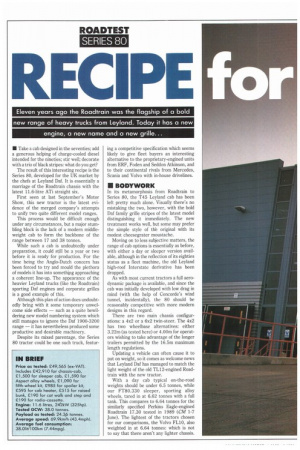REC IPE Eleven years ago the Roadtrain was the flagship of
Page 36

If you've noticed an error in this article please click here to report it so we can fix it.
a bold new range of heavy trucks from Leyland. Today it has a new engine, a new name and a new grille...
• Take a cab designed in the seventies; add a generous helping of charge-cooled diesel intended for the nineties; stir well; decorate with a trio of black stripes: what do you get?
The result of this interesting recipe is the Series 80, developed for the UK market by the chefs at Leyland Daf. It is essentially a marriage of the Roadtrain chassis with the latest 11.6-litre ATi straight six.
First seen at last September's Motor Show, this new tractor is the latest evidence of the merged company's attempts to unify two quite different model ranges.
This process would be difficult enough under any circumstances, but a major stumbling block is the lack of a modern middleweight cab to form the backbone of the range between 17 and 38 tonnes.
While such a cab is undoubtedly under preparation, it could still be a year or two before it is ready for production. For the time being the Anglo-Dutch concern has been forced to try and mould the plethora of models it has into something approaching a coherent line-up. The appearance of the heavier Leyland trucks (like the Roadtrain) sporting Daf engines and corporate grilles is a good example of this.
Although this plan of action does undoubtedly bring with it some temporary unwelcome side effects — such as a quite bewildering new model numbering system which stilt manages to ignore the Daf 1900-3200 range — it has nevertheless produced some productive and desirable machinery.
Despite its mixed parentage, the Series 80 tractor could be one such truck, featur ing a competitive specification which seems likely to give fleet buyers an interesting alternative to the proprietary-engined units from ERF, Foden and Seddon Atkinson, and to their continental rivals from Mercedes, Scania and Volvo with in-house drivelines.
• BODYWORK
In its metamorphosis from Roadtrain to Series 80, the 145 Leyland cab has been left pretty much alone. Visually there's no mistaking the two, however, with the bold Daf family grille stripes of the latest model distinguishing it immediately. The new treatment works well, but some may prefer the simple style of thb original with its modest cheesegrater moustache.
Moving on to less subjective matters, the range of cab options is essentially as before, with either a day or sleeper version available, although in the reflection of its eighties status as a fleet machine, the old Leyland high-roof Interstate derivative has been dropped.
As with most current tractors a full aerodynamic package is available, and since the cab was initially developed with low drag in mind (with the help of Concorde's wind tunnel, incidentally), the 80 should be reasonably competitive with more modern designs in this regard.
There are two main chassis configurations: a 4x2 or a 6x2 twin-steer. The 4x2 has two wheelbase alternatives: either 3.22m (as tested here) or 4.00m for operators wishing to take advantage of the longer trailers permitted by the 16.5m maximum length regulations.
Updating a vehicle can often cause it to put on weight, so it comes as welcome news that Leyland Daf has managed to match the light weight of the old TL12-engined Roadtrain with the new tractor.
With a day cab typical on-the-road weights should be under 6.5 tonnes, while our FT80.330 sleeper, sporting alloy wheels, tared in at 6.62 tonnes with a full tank. This compares to 6.64 tonnes for the similarly specified Perkins Eagle-engined Roadtrain 17.30 tested in 1989 (CM 1-7 June). The lightest of the tractors chosen for our comparisons, the Volvo FL10, also weighted in at 6.64 tonnes: which is not to say that there aren't any lighter chassis.




















































































